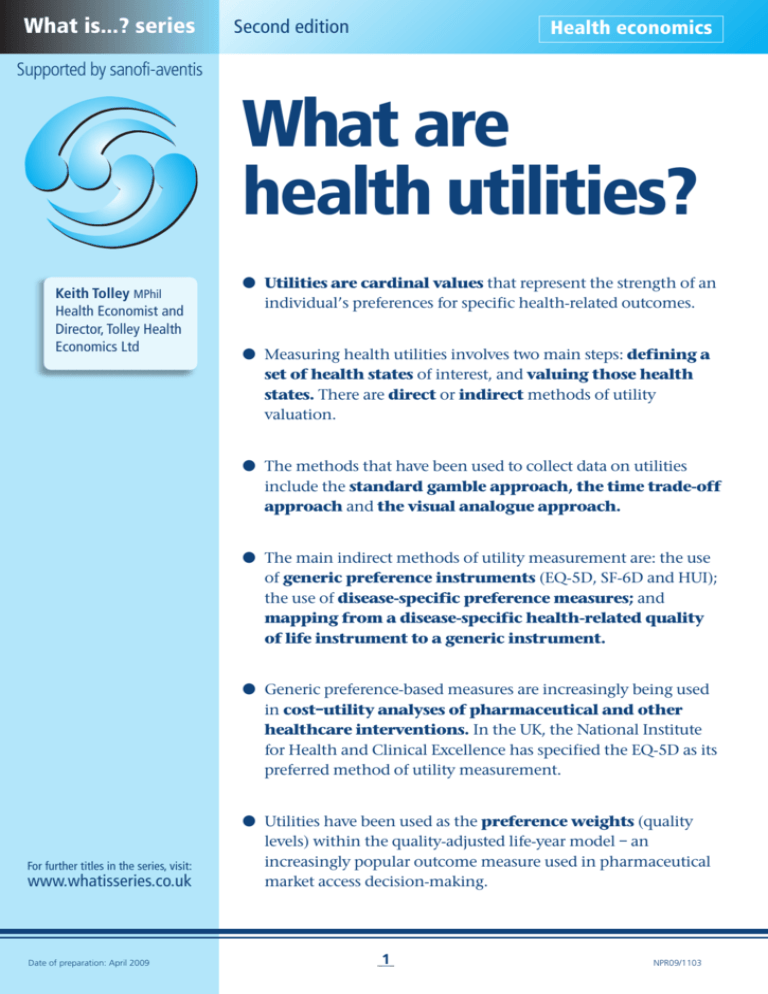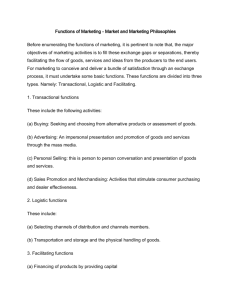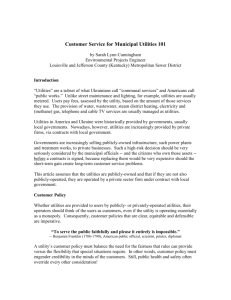
What is...? series
Second edition
Health economics
Supported by sanofi-aventis
What are
health utilities?
Keith Tolley MPhil
Health Economist and
Director, Tolley Health
Economics Ltd
● Utilities are cardinal values that represent the strength of an
individual’s preferences for specific health-related outcomes.
● Measuring health utilities involves two main steps: defining a
set of health states of interest, and valuing those health
states. There are direct or indirect methods of utility
valuation.
● The methods that have been used to collect data on utilities
include the standard gamble approach, the time trade-off
approach and the visual analogue approach.
● The main indirect methods of utility measurement are: the use
of generic preference instruments (EQ-5D, SF-6D and HUI);
the use of disease-specific preference measures; and
mapping from a disease-specific health-related quality
of life instrument to a generic instrument.
● Generic preference-based measures are increasingly being used
in cost–utility analyses of pharmaceutical and other
healthcare interventions. In the UK, the National Institute
for Health and Clinical Excellence has specified the EQ-5D as its
preferred method of utility measurement.
For further titles in the series, visit:
www.whatisseries.co.uk
Date of preparation: April 2009
● Utilities have been used as the preference weights (quality
levels) within the quality-adjusted life-year model – an
increasingly popular outcome measure used in pharmaceutical
market access decision-making.
1
NPR09/1103
What are
health utilities?
What are health utilities?
In health economics, utilities are cardinal
values that reflect an individual’s preferences
for different health outcomes. They are
measured on an interval scale with zero
reflecting states of health equivalent to death
and one reflecting perfect health. In health
economics, utilities are typically combined
with survival estimates and aggregated across
individuals to generate quality-adjusted lifeyears (QALYs) for use in cost–utility analyses
of healthcare interventions (Box 1).1,2
Utility measurement consists of two main
components. These are:
● The definition and description of a set of
health states of interest
● The valuation of those health states (that is,
measurement of the strength of preference
for each health state).
These components can be applied in two
broad ways.3
● Direct measurement of utilities can be
performed for discrete condition-specific
health states.
● Indirect measurement of utilities can
be performed by applying utility
algorithms to generic or disease-specific
preference-based questionnaires, or by
Box 1. Quality-adjusted life-years
(QALYs) in practice
Let us assume that there are two treatments
for an illness. Both treatments extend the
life expectancy of an individual by eight
years. However, treatment A results in the
individual surviving the years in full health
(usually represented by a utility score of 1 on
a cardinal scale), while treatment B results in
the individual surviving the years in a health
state with a utility score of 0.5. Treatment A
has led to a gain in QALYs of 8 (8 x 1), while
treatment B has led to a gain in QALYs of 4
(8 x 0.5).
Date of preparation: April 2009
2
mapping from a disease-specific healthrelated quality of life (HRQoL) instrument
onto the utility algorithm of a generic
instrument such as the EQ-5D (EuroQol
five dimension).
Direct measurement
methods
There are several pertinent issues to consider
in the use of direct measurement approaches,
three of which are discussed below.
● What are the relevant health dimensions?
● What utility valuation method should be
used?
● Whose preferences should be measured?
What are the relevant health
dimensions?
It is important that the relevant
dimensions and levels of health are
assessed. If these dimensions and levels do
not correspond to patient outcomes, it will
not be possible to detect differences even if
such differences exist.
Within the context of utility
measurement, health dimensions are
referred to as attributes. Examples of
health attributes include: physical, social
and cognitive function; psychological wellbeing; symptoms; and pain. These are
incorporated into a health state description
(sometimes referred to as a ‘vignette’) for
the particular disease or condition of
interest; for example, epileptic seizure
frequency health state descriptions, or
visual impairment severity health state
descriptions.
The descriptions should ideally be based
on direct patient experience, although in the
interest of speed and feasibility many utility
studies have used clinicians or other health
professionals as proxies backed by literature
evidence. The descriptions should not
contain more than about five to nine
attributes. Research indicates that this is the
limit to the amount of information that
humans can simultaneously process.4
NPR09/1103
What are
health utilities?
Care should also be exercised to minimise
context effects in health state descriptions.
There may be labelling effects; for example,
the use of the term anaemia/fatigue could be
perceived and valued differently depending
on whether or not it is labelled in the context
of cancer.
What utility valuation method
should be used?
There are a number of valuation methods
that have been used empirically in studies.
These include standard gamble (SG), time
trade-off (TTO), rating scales, equivalence
technique, ratio scaling and person trade-off.
The first three are the most frequently used in
direct measurement studies and so are the
focus here.
Standard gamble
The SG approach is the classic method of
measuring preferences in economics
under conditions of uncertainty, and was
first presented by von Neumann and
Morgenstern.5 SG utilities are fully
consistent with expected utility theory
and the axioms of rational individual
behaviour.
The SG approach involves presenting
individuals with a choice between two
alternatives: a health state that is certain (for
example, frequent migraine attacks) and a
gamble with one better (for example, full
health) and one worse (for example, death)
outcome possible. Respondents are asked
what probability of the better outcome
would make them indifferent between
remaining in the described (migraine)
health state for certain or going for the risky
option. Hence, if they are indifferent
between the migraine state and a gamble
with a 0.8 probability of the better outcome
(but 0.2 probability of the worse outcome),
0.8 represents the utility of the migraine
health state.
The utilities generated by the SG approach
are dependent on the risk behaviour of the
individuals surveyed. In general, individual
behaviour is risk averse, meaning respondents
will tend towards the certain outcome rather
than the gamble (producing higher utilities
for the health state than the risk-seeking
behaviour).6
Date of preparation: April 2009
3
Time trade-off
The TTO approach involves asking subjects to
consider the relative amounts of time (for
example, number of life-years) they would be
willing to sacrifice to avoid a certain poorer
health state (for example, frequent
migraines). Assuming a scenario of ten years
with frequent migraines, the respondent may
be indifferent between this state and a shorter
lifetime of seven years, resulting in an
estimated utility for the frequent migraine
health state of 0.7 (seven years divided by ten
years).
Utilities generated by the TTO method
essentially represent cardinal ‘values’ based
on value theory rather than expected utility
theory (the basis of SG). The importance of
this is that TTO assumes risk neutrality as a
choice is made under conditions of certainty
(that is, there are no risks); therefore, if
individuals are indeed risk averse, the utility
for the same health state generated by SG is
expected to be higher than the value
generated by TTO.
A practical issue in TTO studies is the
choice of lifetime duration for TTO studies.
A review found this varied between one
month and 30 years.7 The impact this has on
the utility estimates generated is
inconclusive.
Rating scale (visual analogue scale)
The rating scale (or visual analogue scale
[VAS]) is based on psychometric theory. It
consists of a single line with anchors
representing best possible health and death
(or some alternative). Respondents are asked
to place each health state on the line such
that the intervals between the placements
reflect their perceived differences between the
health states.
The VAS approach generate values rather
than utilities, and has the least grounding in
economic theory as it involves neither any
element of choice nor individual decisionmaking under uncertainty. However, Parkin
and Devlin have argued that the VAS has
important advantages (versus SG and TTO) in
empirical performance.8
Due to its simplicity the VAS is often used
as a ‘warm-up’ to a TTO or SG exercise, as it
allows the respondent to become familiar
with comparing the health states.
NPR09/1103
What are
health utilities?
Comparing the valuation methods
In general, health economists support the use
of choice-based methods (SG or TTO) over
the VAS. However, the SG approach is
relatively time-consuming and people often
have difficulty understanding the concept of
probabilities. For many, the TTO represents a
reliable and practical middle way, although
the trade-off concept could still be difficult
for many people to understand.
The choice of method matters as the
differences in theoretical grounding and
valuation approach can lead to differences in
utility estimates. A review of utilities across
995 chronic and acute health states found a
strong tendency for VAS to yield the lowest,
TTO the middle and SG the highest utility
values for the same health states.9 Direct
measurement studies may be particularly
useful for valuing specific side-effects or
modes of drug administration (where there
are obvious and plausible differences in QoL
impact).10,11
Whose preferences should be
measured?
The valuation of preferences using SG, TTO or
VAS can be performed by either the public or
patients (or, in the case of young children,
proxies such as caregivers/parents).
● The primary reason for selecting
patients is that they are the people who
experience the impact of the disease and
treatment, so it is their preferences that
should be considered of most importance. If
patients are used, they can be asked to value
a hypothetical health state or their own
health state. While it is more challenging to
recruit patients with the specific health
states of interest, utilities obtained through
hypothetical scenarios may not be valid
predictors of preferences associated with
actual experienced health states.12
● The rationale for measuring the
preferences of the general public for
hypothetical health states is that in a
publicly funded healthcare system, it is
society’s resources that are being allocated
and so it is the views of the general
population that are most relevant.1
The question of whose preference to
measure is important because there is some
evidence that utilities differ between
Date of preparation: April 2009
4
different population groups. In general,
patient values for hypothetical health states
that are likely to be worse than their current
health state tend to be higher than those
from the general public. This may be related
to patients’ coping mechanisms when
addressing ill health.13
There are situations in which proxies are
necessary; for example, when measuring
young children’s preferences. In a study
conducted in a mixed UK population sample,
parents/caregivers produced higher utilities
than the general public in the context of
Lennox–Gastaut syndrome – a severe form of
childhood epilepsy.11 Increasingly, the proxy
values of clinicians or other healthcare
professionals are recognised as not
representing a valid or reliable source for
utilities.14
A further issue is the minimum sample size
for public- or patient-based valuation studies.
No rules have been set for this and many
utility studies have been conducted on very
small sample sizes.15 In general, a rule of
thumb is that, to be considered reliable,
population-based studies should have a
minimum of 100 respondents representing a
cross section of society. Achieving sufficiently
large sample sizes becomes more difficult
with patient-based valuation studies,
especially if based on patients experiencing
the actual health state. Also, there is a limit to
the number of health states that each
respondent can cope with – a rule of thumb is
a maximum of ten but fewer if possible, due
to interview fatigue (this also depends on the
skills of the interviewer and the
administration techniques used).
Indirect measurement
methods
Generic utility instruments
By far the most well-known indirect method
is the generic utility instrument, whereby a
set of non-disease-specific health states, based
on a combination of general attributes, have
been valued by a general public sample.
Three instruments in common use today
are the EQ-5D, the SF-6D (Short Form six
dimension) and the HUI (Health Utilities
Index), although there are other instruments
used globally (for example, QWB [Quality of
NPR09/1103
What are
health utilities?
Well-Being] and 15D [15 dimension]).1
For each instrument, the public values a
limited number of health states and a scoring
algorithm is developed using econometric
modelling (EQ-5D and SF-6D) or a
multiplicative multi-attribute utility function
(HUI) to predict utilities for other health
states not directly valued. Patients with any
health condition then complete a simple
questionnaire which defines the generic
health state they are in, and the appropriate
utility from the scoring algorithm is applied.
The instruments differ in the specific
general attributes used for their descriptive
systems and in the method of valuation
applied – the EQ-5D has been valued using
TTO, while the SF-6D is a derivative of the SF36 (Short Form 36 item) and has been valued
using SG. The HUI has two classification
systems (HUI2 and HUI3) which differ in
attributes but were also measured by SG. All,
however, have been valued by large general
public samples.
Generic utility instruments address some
of the practical difficulties of conducting
direct TTO or SG exercises. A large amount of
research effort by separate EQ-5D, SF-6D and
HUI research teams has gone into the
development of standard, off-the-shelf
questionnaires that can be completed in a few
minutes by patients in randomised, clinical
trials or observational studies. The second
advantage of generic instruments from a
decision-maker’s perspective is that they
generate general health state utilities that can
be used to compare QALYs gained for
interventions across patient groups and
diseases to aid broad health service resourceallocation decisions.
However, there are a number of potential
limitations with generic preference-based
instruments.
● They may lack sensitivity in specific disease
contexts.
● They are difficult to apply to acute
conditions (for example, an asthma
exacerbation) or when assessing smaller
differences in utility (for example, those
associated with mode of drug
administration or specific drug-related sideeffects).
● There is evidence of ceiling effects with the
EQ-5D and floor effects with the SF-6D.16
Date of preparation: April 2009
5
● They generate different estimates for the
same condition, which is related to their
differences in valuation methods and
scoring algorithms. For example, a study of
the QoL of hearing-impaired people found
mean utility scores were similar using the
EQ-5D and SF-6D (0.77 and 0.79
respectively), but much lower using the
HUI3 (0.56).17
Disease-specific utility instruments
In response to sensitivity issues with the
generic measures, preference-based diseasespecific measures are beginning to be
developed. The principle here is that the
utilities attached to a disease-specific HRQoL
instrument are generated in the same way as
with a generic instrument. Examples of
preference-based scoring systems generated
this way include the International Prostate
Symptom Score (IPSS) for benign prostatic
hyperplasia,18 the International Index of
Erectile Function (IIEE)19 and the Cambridge
Pulmonary Hypertension Outcome Review
(CAMPHOR).20 All have been valued using
TTO methodology.
The construction of these instruments is
promising, but they are still at a relatively
early stage of development, so their value for
decision-making has yet to be realised. They
have the advantage of generating potentially
sensitive disease-specific utilities through
application of a validated HRQoL instrument
in a clinical trial. However, the main practical
limitation is the amount of research effort
required to generate the utility scales; hence, a
limited number of diseases have been covered
so far.
Mapping utilities
A variant to developing a disease-specific
utility measure is to map the descriptions
from a disease-specific QoL instrument onto
the utility algorithm of a generic instrument.
This method is often used when a generic
instrument is not available, but a suitable
disease-specific QoL instrument has been
included in clinical trials.
While it is possible to perform mapping
based on clinician judgement, the rigour of
this approach can be enhanced by using an
empirical database containing both the
HRQoL instrument and a generic instrument
NPR09/1103
What are
health utilities?
EQ-5D in trial*
Trial A1 vs C1
No EQ-5D in the trial, but
there is a disease-specific HRQoL
questionnaire and relevant
EQ-5D data available out of
the trial
Mapping to EQ-5D
No EQ-5D data, but there is a
validated HRQoL questionnaire
in the trial
Direct valuations
Discrete health states based
on HRQoL instrument and
valued in UK population
sample using TTO
* Or other validated instrument with similar properties if EQ-5D not appropriate, or use HUI2 in children
HRQoL: health-related quality of life; TTO: time trade-off
Figure 1. NICE hierarchy of utility methods14
such as the EQ-5D administered to the same
patient to generate a mapping function. Even
so, caution is needed in interpreting mapping
functions derived this way, as a range of
estimation methods have been applied in
previous studies with varying levels of
statistical robustness.21
Use of utilities in decisionmaking
As the use of economic evaluation for
pharmaceutical market access decisionmaking increases globally, QALYs and, hence,
utility assessments are being used as a key
outcome measure within those evaluations.
In the UK, the calculation of QALYs is a
central part of the reference case for
economic evaluations of pharmaceuticals
submitted to the National Institute for Health
and Clinical Excellence (NICE).14,22 NICE has a
hierarchy of methods for the derivation of
utilities, with the use of the EQ-5D within
clinical trials being the preferred method.
However, if it is not available, utilities can be
derived using the TTO valuation method in
community-based respondent samples (Figure
1).14 Other bodies in the UK (for example, the
Scottish Medicines Consortium [SMC]) and
other countries are less prescriptive and allow
a variety of methods to be used as long as
they are performed robustly and the utility
values generated for the health states appear
plausible.
Date of preparation: April 2009
6
References
1. Drummond MF, Sculpher MJ, Torrance GW, O’Brien
BJ, Stoddart GL. Methods for the Economic Evaluation of
Health Care Programmes, 3rd edn. Oxford: Oxford
University Press, 2005.
2. Torrance GW. Measurement of health state utilities
for economic appraisal. J Health Econ 1986; 5: 1–30.
3. Szende A, Schaefer C. A taxonomy of health utility
assessment methods and the role for uncertainty
analysis. Eur J Health Econ 2006; 7: 147–151.
4. Miller GA. The magical number seven plus or minus
two: some limits on our capacity for processing
information. Psychol Rev 1956; 63: 81–97.
5. von Neumann J, Morgenstern O. Theory of Games and
Economic Behavior 3rd edn. New York: John Wiley, 1953.
6. Torrance GW, Furlong W, Feeny D, Boyle M. Multiattribute preference functions. Health Utilities Index.
Pharmacoeconomics 1995; 7: 503–520.
7. Arnesen T, Trommald M. Are QALYs based on time
trade-off comparable?—A systematic review of TTO
methodologies. Health Econ 2005; 14: 39–53.
8. Parkin D, Devlin N. Is there a case for using visual
analogue scale valuations in cost-utility analysis? Health
Econ 2006; 15: 653–664.
9. Morimoto T, Fukui T. Utilities measured by rating
scale, time trade-off, and standard gamble: review and
reference for health care professionals. J Epidemiol 2002;
12: 160–178.
10. Osborne RH, de Abreu Lourenco R, Dalton A et al.
Quality of life related to oral versus subcutaneous iron
chelation: a time trade-off study. Value Health 2007; 10:
451–456.
11. Yi Y, Verdian L, Oyee J, Tolley K, Heyes A. Eliciting
utility scores for health states associated with
Lennox–Gastaut syndrome. 2008; 11: A606.
12. Jansen SJ, Stiggelbout AM, Wakker PP et al. Unstable
preferences: a shift in valuation or an effect of the
elicitation procedure? Med Decis Making 2000; 20:
62–71.
13. Ubel PA, Loewenstein G, Jepson C. Whose quality of
life? A commentary exploring discrepancies between
health state evaluations of patients and the general
public. Qual Life Res 2003; 12: 599–607.
14. National Institute for Health and Clinical Excellence.
Guide to the methods of technology appraisal (June 2008).
www.nice.org.uk/media/B52/A7/TAMethodsGuideUpdat
edJune2008.pdf (last accessed 9 December 2008)
15. Tufts Medical Center. Cost-Effectiveness Analysis
Registry (CEA). https://research.tuftsnemc.org/cear/default.aspx (last accessed 9 December
2008)
16. Ferreira PL, Ferreira LN, Pereira LN. How consistent
are health utility values? Qual Life Res 2008; 17:
1031–1042.
17. Barton GR, Bankart J, Davis AC. A comparison of the
NPR09/1103
What are
health utilities?
quality of life of hearing-impaired people as estimated
by three different utility measures. Int J Audiol 2005; 44:
157–163.
18. Kok ET, McDonnell J, Stolk EA, Stoevelaar HJ,
Busschbach JJ. The valuation of the International
Prostate Symptom Score (IPSS) for use in economic
evaluations. Eur Urol 2002; 42: 491–497.
19. Stolk EA, Busschbach JJ. Validity and feasibility of the
use of condition-specific outcome measures in economic
evaluation. Qual Life Res 2003; 12: 363–371.
20. McKenna SP, Ratcliffe J, Meads DM, Brazier JE.
Date of preparation: April 2009
7
Development and validation of a preference based
measure derived from the Cambridge Pulmonary
Hypertension Outcome Review (CAMPHOR) for use in
cost utility analyses. Health Qual Life Outcomes 2008; 6:
65.
21. Brazier J, Ratcliffe J, Tsuchiya A, Salomon J. Measuring
and Valuing Health Benefits for Economic Evaluation.
Oxford: Oxford University Press, 2007.
22. Brazier J. Valuing health states for use in costeffectiveness analysis. Pharmacoeconomics 2008; 26:
769–779.
NPR09/1103
What is...? series
What are
health utilities?
First edition published 2001
Author: Stavros Petrou
This publication, along with
the others in the series, is
available on the internet at
www.whatisseries.co.uk
The data, opinions and statements
appearing in the article(s) herein
are those of the contributor(s)
concerned. Accordingly, the
sponsor and publisher, and their
respective employees, officers
and agents, accept no liability
for the consequences of any such
inaccurate or misleading data,
opinion or statement.
Published by Hayward Medical
Communications, a division of
Hayward Group Ltd.
Copyright © 2009 Hayward
Group Ltd.
All rights reserved.
Supported by sanofi-aventis
Date of preparation: April 2009
8
NPR09/1103






